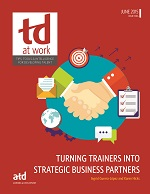ATD Blog
SCALE: Aligning Talent Development Solutions to Strategic Objectives
Wed Jul 29 2015


Consider your last talent development initiative and reflect on whether you had clear answers to the following questions before the solution was selected:
What performance results do we expect from employees after implementing the solution?
How will we measure the impact of our solution on the organization’s performance?
What are the organizational barriers that may interfere with the impact of our talent development solution in the workplace?
How do (and will) our managers support performance in the organization?
How do we ensure that desired workplace performance is maintained?
As a talent development executive, you have an important responsibility in uncovering the answers to these questions, as they help the team and other organizational members clarify strategic priorities, determine the use of resources, and offer guidance on how products and services may be offered to external clients. All of these decisions are focused on creating a sustainable strategic advantage for the organization, rather than on fulfilling training requests.
Enter SCALE, a structured, yet flexible, process for ensuring that your talent development solutions are clearly aligned with strategic objectives and generate measurable evidence of your contributions to the organization’s success.
The SCALE process consists of three phases, with three steps in each phase.
Phase 1: Understand Stakeholders’ Perceptions of Needs
Phase one helps you understand the performance needs from various stakeholder perspectives. Stakeholders in this instance include the person who made the original request for assistance with a performance problem, and those who will affect or be affected by a selected solution. By considering these perspectives, you can choose the appropriate level of organizational alignment for the performance solution.
Critical steps include:
discover issues from requestor’s perspective
discover issues from perspectives of others
align stakeholder perspectives to decide alignment level.
Phase 2: Design Alignment
Phase two helps you discover the gaps in performance results for the selected level of alignment, select the solution that is appropriately aligned to gaps in results and their root causes, and work with stakeholders to create an implementation plan.
Critical steps include:
discover gaps in performance results in chosen alignment level
select solutions aligned to gaps and root causes
implementation planning and execution.
Phase 3: Track and Confirm Alignment Results
Phase three helps you track and confirm the results of the selected solution. With the solution in place, you will discover the accomplishments to date, determine the alignment to date, and make decisions about how to continuously improve performance or sustain desired results. In addition to these technical aspects of SCALE, the essential skills that drive your ability to perform each of these steps successfully are identified with examples of how each is applied throughout the process.
Critical steps include:
discover accomplishments to date
determine achieved alignment to date
make continuous improvement decisions, as required.
Editor’s Note: This post is excerpted from the June 2015 TD at Work_,_ “Turning Trainers Into Strategic Business Partners.” This issue describes:
how learning and talent development (LTD) professionals can reinvigorate their roles in their organization
essential skills for the new generation of LTD professionals
the SCALE process, and how it can help you match training initiatives with business objectives
how to uncover stakeholder perspectives, optimize strategic alignment, and monitor your training effectiveness.
You've Reached ATD Member-only Content
Become an ATD member to continue
Already a member?Sign In
